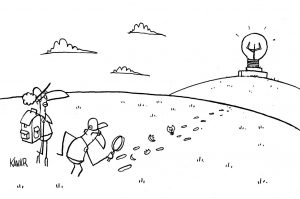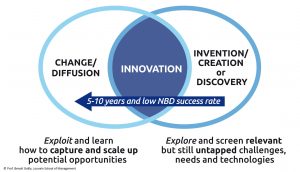 Capturing innovation opportunities requires crafting decision-making processes and working in dual learning modes, with phases – or “stages” – of intensive and focused development and experimentation combined with moments – or “gates” – of questioning and prioritization.
Capturing innovation opportunities requires crafting decision-making processes and working in dual learning modes, with phases – or “stages” – of intensive and focused development and experimentation combined with moments – or “gates” – of questioning and prioritization.
 Steering innovation projects and teams requires combining the discipline of focused project portfolio and clear management commitments with an environment that fosters leadership, risk-taking and experimentation.
Steering innovation projects and teams requires combining the discipline of focused project portfolio and clear management commitments with an environment that fosters leadership, risk-taking and experimentation.

Crossing the gap between a fuzzy innovation idea and sizeable value creation requires dedicated resources and capabilities, both to explore and frame selected potential opportunities and to exploit and scale up potential new businesses. Innovation is real work, requiring significant and specific time and resources.
Bibliography
Learning while delivering: crafting the right decision process
Keywords: agile, flexibility, lean start-up, learning, management attention, prioritization, stage-gate
- (Book) Furr, N. R., & Dyer, J. (2014). The Innovator’s Method: Bringing the Lean Startup Into Your Organization. Harvard Business Press.
- (Book) Ries, Eric. The lean startup: How today’s entrepreneurs use continuous innovation to create radically successful businesses. Crown Business, 2011.
- (Video) Implementing Stage-Gate® in the Real World; Sopheon
- (Video) Innovation Process by Kuczmarski Innovation (on Vimeo)
- (Video) Agile working: an innovation in the way we work | Anne Cantelo | TEDxWoking.
- (Video) Lean Startup Meets Design Thinking
- (Video) Steve Blank : The principles of Lean
- (Video) The Innovator’s Method: How Great Innovators Lead Differently by Jeff Dyer and Nathan Furr; December 10, 2014.
- (Article) Amara, N., Landry, R., Becheikh, N., & Ouimet, M. (2008). Learning and novelty of innovation in established manufacturing SMEs. Technovation, 28(7), 450-463.
- (Article) Antons, D., Brettel, M., Hopp, C., Salge, T. O., Piller, F., & Wentzel, D. (2019). Stage-gate and agile development in the digital age: Promises, perils, and boundary conditions. Journal of Business Research, 110, 495-501.
- (Article) Blank, S. (2013). Why the lean start-up changes everything. Harvard Business Review, 91(5), 63-72.
- (Article) Bortolini, R. F., Cortimiglia, M. N., Danilevicz, A. D. M. F., & Ghezzi, A. (2018). Lean Startup: a comprehensive historical review. Management Decision.
- (Article) Camuffo, A., Cordova, A., Gambardella, A., & Spina, C. (2019). A scientific approach to entrepreneurial decision making: Evidence from a randomized control trial. Management Science.
- (Article) Chew, W. Bruce, Dorothy Leonard-Barton, and Roger E. Bohn. “Beating Murphy’s law.” MIT Sloan Management Review 32.3 (1991): 5.
- (Article) Cooper, R. G., & Kleinschmidt, E. J. (1986). An investigation into the new product process: steps, deficiencies, and impact. Journal of Product Innovation Management, 3(2), 71-85.
- (Article) Cooper, R. G. (1999). From experience: the invisible success factors in product innovation. Journal of Product Innovation Management, 16(2), 115-133.
- (Article) Cooper, R.G. (2014). What’s Next?: After Stage-Gate. Research-Technology Management, 57(1), 20-31.
- (Article) Cooper, R.G., Edgett, S. J., & Kleinschmidt, E. J. (2002). Optimizing the stage-gate process: what best-practice companies do—I. Research-Technology Management, 45(5), 21-27.
- (Article) Cooper, R. G., & Edgett, S. J. (2008). Maximizing productivity in product innovation. Research-Technology Management, 51(2), 47-58.
- (Article) Cooper, R.G., & Sommer, A.F. (2016). The Agile–Stage‐Gate Hybrid Model: A Promising New Approach and a New Research Opportunity. Journal of Product Innovation Management, 33(5), 513-526.
- (Article) Covin, J. G., Garrett Jr, R. P., Gupta, J. P., Kuratko, D. F., & Shepherd, D. A. (2018). The interdependence of planning and learning among internal corporate ventures. Entrepreneurship Theory and Practice, 42(4), 537-570.
- (Article) Denning, S. (2013). Why Agile can be a game change for managing continuous innovation in many industries. Strategy & Leadership, 41(2), 5 – 11.
- (Article) Denning, S. (2017). The age of Agile. Strategy & Leadership, 45(1), 3-10.
- (Article) Eisenhardt, K. M., & Tabrizi, B. N. (1995). Accelerating adaptive processes: Product innovation in the global computer industry. Administrative Science Quarterly, 40(1), 84-110.
- (Article) Ettlie, J.E., & Elsenbach, J.M. (2007). Modified Stage‐Gate® Regimes in New Product Development. Journal of Product Innovation Management, 24(1), 20-33.
- (Article) Felin, T., Gambardella, A., Stern, S., & Zenger, T. (2019). Lean startup and the business model: Experimentation revisited. Forthcoming in Long Range Planning (Open Access). https://doi.org/10.1016/j.lrp.2019.06.002
- (Article) Frederiksen, D. L., & Brem, A. (2017). How do entrepreneurs think they create value? A scientific reflection of Eric Ries’ Lean Startup approach. International Entrepreneurship and Management Journal, 13(1), 169-189.
- (Article) Ghezzi, A. (2019). Digital startups and the adoption and implementation of Lean Startup Approaches: Effectuation, Bricolage and Opportunity Creation in practice. Technological Forecasting and Social Change, 146, 945-960.
- (Article) Ghezzi, A., & Cavallo, A. (2020). Agile business model innovation in digital entrepreneurship: Lean startup approaches. Journal of Business Research, 110, 519-537.
- (Article) Grönlund, J., Sjödin, D.R., & Frishammar, J. (2010). Open innovation and the stage-gate process: A revised model for new product development. California Management Review, 52(3), 106-131.
- (Article) Hobday, M. (2005). Firm-level innovation models: perspectives on research in developed and developing countries. Technology Analysis & Strategic Management, 17(2), 121-146.
- (Article) Hommels, A., Peters, P., & Bijker, W. E. (2007). Techno therapy or nurtured niches? Technology studies and the evaluation of radical innovations. Research Policy, 36(7), 1088-1099.
- (Article) Knudsen, M.P., & Mortensen, T.B. (2011). Some immediate–but negative–effects of openness on product development performance. Technovation, 31(1), 54-64.
- (Article) Krishnan, V., & Ulrich, K. T. (2001). Product development decisions: A review of the literature. Management Science, 47(1), 1-21.
- (Article) Leonard-Barton, D. (1992). ‘Core capabilities and core rigidities: a paradox in managing new product development’. Strategic Management Journal, 13, 111-125.
- (Article) MacCormack, A., Verganti, R., & Iansiti, M. (2001). Developing products on “Internet time”: The anatomy of a flexible development process. Management Science, 47(1), 133-150.
- (Article) Meyer, M. H., & Marion, T. J. (2010). Innovating for effectiveness: Lessons from design firms. Research-Technology Management, 53(5), 21-28.
- (Article) Rigby, D. K., Sutherland, J., & Takeuchi, H. (2016). Embracing agile. Harvard Business Review, 94(5), 40-50.
- (Article) Robert, M.R. (2014). Agile at IBM: software developers teach a new dance step to management. Strategy & Leadership, 42(2), 26 – 29.
- (Article) Schot, J., & Geels, F. W. (2008). Strategic niche management and sustainable innovation journeys: theory, findings, research agenda, and policy. Technology Analysis & Strategic Management, 20(5), 537-554.
- (Article) Shepherd, D. A., & Gruber, M. (2020). The Lean Startup Framework: Closing the Academic–Practitioner Divide. Entrepreneurship Theory and Practice, 1042258719899415.
- (Article) Tidd, J., & Bodley, K. (2002). The influence of project novelty on the new product development process. R&D Management, 32(2), 127-138.
- (Article) Velu, C., & Stiles, P. (2013). Managing decision-making and cannibalization for parallel business models. Long Range Planning, 46(6), 443-458.
- (Article) Yli‐Renko, H., Autio, E., & Sapienza, H. J. (2001). Social capital, knowledge acquisition, and knowledge exploitation in young technology‐based firms. Strategic Management Journal, 22(6‐7), 587-613.
Discipline and care: steering innovation projects and teams
Keywords: hypothesis-driven, not project management, portfolio monitoring, pressure
- (Book) Govindarajan, V., & Trimble, C. (2010). The other side of innovation: Solving the execution challenge. Harvard Business Press.
- (Video) Why Most Product Launches Fail, by Joan Schneider and Julie Hall (HBR)
- (Video) Prof. Rita McGrath, Columbia Business School (2013), Five Ways to Ruin Your Innovation Process
- (Article) Amabile, T.M., Hadley, C.N., & Kramer, S.J. (2002). Creativity under the gun. Harvard Business Review, 80, 52-63.
- (Article) Baer, M., & Oldham, G. R. (2006). The curvilinear relation between experienced creative time pressure and creativity: moderating effects of openness to experience and support for creativity. Journal of Applied Psychology, 91(4), 963.
- (Article) Benders, J., & Vermeulen, P. (2002). Too many tools? On problem solving in NPD projects. International Journal of Innovation Management, 6(02), 163-185.
- (Article) Bernstein, B., & Singh, P. J. (2006). An integrated innovation process model based on practices of Australian biotechnology firms. Technovation, 26(5-6), 561-572.
- (Article) Blank, S., & Newell, P. (2017). What your innovation process should look like. Harvard Business Review.
- (Article) Bonner, J.M., Ruekert, R.W., & Walker, O.C. (2002). Upper management control of new product development projects and project performance. Journal of Product Innovation Management, 19(3), 233-245.
- (Article) Bradley, S. W., Wiklund, J., & Shepherd, D. A. (2011). Swinging a double-edged sword: The effect of slack on entrepreneurial management and growth. Journal of Business Venturing, 26(5), 537-554.
- (Article) Brattström, A., Löfsten, H., & Richtnér, A. (2012). Creativity, trust and systematic processes in product development. Research Policy, 41(4), 743-755.
- (Article) Chen, Y.-C., Li, P.-C., & Lin, Y.-H. (2013). How inter- and intra-organisational coordination affect product development performance: the role of slack resources. Journal of Business & Industrial Marketing , 28 (1-2), 125-136.
- (Article) Cooper, R. G. (1994). Third‐generation new product processes. Journal of Product Innovation Management, 11(1), 3-14.
- (Article) Cooper, R. G. (2021). Accelerating innovation: some lessons from the pandemic. Journal of Product Innovation Management, 38(2), 221-232.
- (Article) D’Alvano, L., & Hidalgo, A. (2012). Innovation management techniques and development degree of innovation process in service organizations. R&D Management, 42(1), 60-70.
- (Article) Dooley, K. J., Subra, A., & Anderson, J. (2002). Adoption rates and patterns of best practices in new product development. International Journal of Innovation Management, 6(01), 85-103.
- (Article) Dougherty, D., Bertels, H., Chung, K., Dunne, D. D., & Kraemer, J. (2013). Whose time is it? Understanding clock-time pacing and event-time pacing in complex innovations. Management and Organization Review, 9(2), 233-263.
- (Article) Hill, L.A., & Davis, G. (2017). The Board’s new innovation imperative. Harvard Business Review, 95(6), 103-109.
- (Article) Lewis, M. W. (2000). Exploring paradox: Toward a more comprehensive guide. Academy of Management Review, 25(4), 760-776.
- (Article) Markham, S. K., & Lee, H. (2013). Product development and management association’s 2012 comparative performance assessment study. Journal of Product Innovation Management, 30(3), 408-429.
- (Article) Perlow, L.A., Okhuysen, G.A., & Repenning, N.P. (2002). The speed trap: Exploring the relationship between decision making and temporal context. Academy of Management Journal, 45(5), 931-955.
- (Article) Prajogo, D. I., & Sohal, A. S. (2001). TQM and innovation: a literature review and research framework. Technovation, 21(9), 539-558.
- (Article) Salomo, S., Weise, J., & Gemünden, H. G. (2007). NPD planning activities and innovation performance: the mediating role of process management and the moderating effect of product innovativeness. Journal of Product Innovation Management, 24(4), 285-302.
- (Article) Sethi, R., & Iqbal, Z. (2008). Stage-gate controls, learning failure, and adverse effect on novel new products. Journal of Marketing, 72(1), 118-134.
- (Article) Shin, J., & Grant, A. M. (2020). When putting work off pays off: the curvilinear relationship between procrastination and creativity. Academy of Management Journal, (ja).
- (Article) Smith, P. G., & Reinertsen, D. G. (1992). Shortening the product development cycle. Research-Technology Management, 35(3), 44-49.
- (Article) Troilo, G., De Luca, L.M., & Atuahene‐Gima, K. (2014). More innovation with less? A strategic contingency view of slack resources, information search, and radical innovation. Journal of Product Innovation Management, 31(2), 259-277.
From fuzzy front end to value creation: crossing the gap
Keywords: assessment, front-end, gates, incubation, new product development, screening
- (Book) Hill, Susan A., and Stylianos Georgoulas. Handbook of Research on Corporate Entrepreneurship (2016)
- (Book) O’Reilly III, C. A., & Tushman, M. L. (2016). Lead and disrupt: How to solve the innovator’s dilemma. Stanford University Press.
- (Book) Roberts, Michael J., Howard H. Stevenson, William A. Sahlman, Paul Marshall and Richard G. Hamermesh, eds. New Business Ventures and the Entrepreneur. 6th ed. New York: McGraw-Hill/Irwin, 2006.
- (Video) Allocating Resources for Innovation by Kuczmarski Innovation (on Vimeo)
- (Article) Adams, D., & Hublikar, S. (2010). Upgrade your new-product machine. Research-Technology Management, 53(2), 55-67.
- (Article) Barczak, G., Griffin, A., & Kahn, K. B. (2009). Perspective: trends and drivers of success in NPD practices: results of the 2003 PDMA best practices study. Journal of Product Innovation Management, 26(1), 3-23.
- (Article) Biniari, M.G., Simmons, S.A., Monsen, E.W., & Moreno, M.P. (2015). The configuration of corporate venturing logics: An integrated resource dependence and institutional perspective. Small Business Economics, 45(2), 351-367.
- (Article) Breuer, H. (2013). Lean venturing: Learning to create new business through exploration, elaboration, evaluation, experimentation, and evolution. International Journal of Innovation Management, 17(03), 1340013.
- (Article) Burgelman, Robert A. “A process model of internal corporate venturing in the diversified major firm.” Administrative Science Quarterly (1983): 223-244.
- (Article) Cankurtaran, P., Langerak, F., & Griffin, A. (2013). Consequences of new product development speed: A meta‐analysis. Journal of Product Innovation Management, 30(3), 465-486.
- (Article) Cooper, R. G. (2008). The stage-gate idea-to-launch process–update, what’s new and NexGen systems. Journal of Product Innovation Management, 25(3), 213-232.
- (Article) De Brentani, U., & Reid, S. E. (2012). The fuzzy front‐end of discontinuous innovation: Insights for research and management. Journal of Product Innovation Management, 29(1), 70-87.
- (Article) Froehle, C. M., & Roth, A. V. (2007). A resource‐process framework of new service development. Production and Operations Management, 16(2), 169-188.
- (Article) Griffin, A., & Hauser, J. R. (1996). Integrating R&D and marketing: A review and analysis of the literature. Journal of Product Innovation Management: An International Publication of the Product Development & Management Association, 13(3), 191-215.
- (Article) Joh, J., & Mayfield, M. (2009). The discipline of product discovery: identifying breakthrough business opportunities. Journal of Business Strategy, 30(2/3), 70-77.
- (Article) Khilji, S. E., Mroczkowski, T., & Bernstein, B. (2006). From invention to innovation: toward developing an integrated innovation model for biotech firms. Journal of product innovation management, 23(6), 528-540.
- (Article) Khurana, A. & Rosenthal, S.R. (1997). Integrating the Fuzzy Front-End of New Product Development. Sloan Management Review, 38 (2), 103-120.
- (Article) Khurana, A., & Rosenthal, S. R. (1998). Towards holistic “front ends” in new product development. Journal of Product Innovation Management 15(1), 57-74.
- (Article) Kim, J., & Wilemon, D. (2002). Focusing the fuzzy front–end in new product development. R&D Management, 32(4), 269-279.
- (Article) Koen, P., Ajamian, G., Burkart, R., Clamen, A., Davidson, J., D’Amore, R., … & Karol, R. (2001). Providing clarity and a common language to the “fuzzy front end”. Research-Technology Management, 44(2), 46-55.
- (Article) Mansoori, Y., & Lackéus, M. (2019). Comparing effectuation to discovery-driven planning, prescriptive entrepreneurship, business planning, lean startup, and design thinking. Small Business Economics, 1-28.
- (Article) Markham, S. K., Ward, S. J., Aiman‐Smith, L., & Kingon, A. I. (2010). The valley of death as context for role theory in product innovation. Journal of Product Innovation Management, 27(3), 402-417.
- (Article) Markham, S. K. (2013). The impact of front‐end innovation activities on product performance. Journal of Product Innovation Management, 30, 77-92.
- (Article) Markovitch, D. G., O’Connor, G. C., & Harper, P. J. (2017). Beyond invention: the additive impact of incubation capabilities to firm value. R&D Management, 47(3), 352-367.
- (Article) Meyer, M. H., & Utterback, J. M. (1995). Product development cycle time and commercial success. IEEE transactions on engineering management, 42(4), 297-304.
- (Article) O’Connor, G.C., & Rice, M.P. (2013). New market creation for breakthrough innovations: Enabling and constraining mechanisms. Journal of Product Innovation Management, 30(2), 209-227.
- (Article) Rice, M., Kelley, D., Peters, L., & Colarelli O’Connor, G. (2001). Radical innovation: triggering initiation of opportunity recognition and evaluation. R&D Management, 31(4), 409-420.
- (Article) Sosna, M., Trevinyo-Rodríguez, R. N., & Velamuri, S. R. (2010). Business model innovation through trial-and-error learning: The Naturhouse case. Long Range Planning, 43(2-3), 383-407.
- (Article) Yang, X., Sun, S. L., & Zhao, X. (2018). Search and execution: examining the entrepreneurial cognitions behind the lean startup model. Small Business Economics, 1-13
(c) Prof. Benoit Gailly, Louvain School of Management


